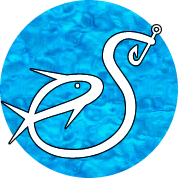 | Safe Handling of Your Self Caught Seafood |
Safe Handling of Self Caught Fish & Seafood
How To Keep Fish Fresh While Fishing
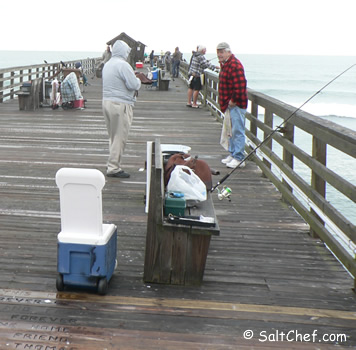 Fish are one of the most perishable foods that we eat. Fish decompose at a much faster rate than red meat and game. And, bacteria grow and spread quickly on fresh fish. The goal is to preserve the flesh as quickly as possible.
Fish are one of the most perishable foods that we eat. Fish decompose at a much faster rate than red meat and game. And, bacteria grow and spread quickly on fresh fish. The goal is to preserve the flesh as quickly as possible.
Don't let the fish die on its own. After you've caught a fish to keep, you do not want it to die on its own. If the fish thrashes around, whether on the deck of the boat, in a fish bin, or in a bucket, the meat will be bruised and this will change the taste of the fish. If the fish takes a long time to die, the stress of that will also increase the odor of the meat. Plus, it's a lot more humane to kill them quickly.
Keep the fish alive or get it into crushed ice immediately.
Whether you're fishing from a boat, a fishing pier or from the shore, you need to decide how you're going to handle the fish once you catch them. The choice is to either keep them alive or get them into ice.
Whatever method you use for keeping your catch fresh, if you get home and have any doubts at all about the freshness of the fish, throw it out.
Note: if you opt for keeping the fish alive while you're fishing, you need to get them home in the freshest condition possible. This means that you will still need to use one of the ice methods below. Unless, of course, you're going to eat them within 5 minutes of pulling them out of the water!
- Fish can be kept on a stringer in the water. You will need to check on them though - this is not a full proof method. If you're surf fishing, this isn't always a good option.
- Or you can purchase a big bucket with a built-in aerator. Assuming the fish can move around in the bucket – this should keep them alive. These are sometimes referred to as live wells.
- There are baskets out there, usually made of wire mesh, that are designed to keep your catch alive. They have a self closing mechanism. Attach a rope to the basket and hang it in the water. Make sure there's enough room for the fish to swim freely and that the basket is fully submerged.
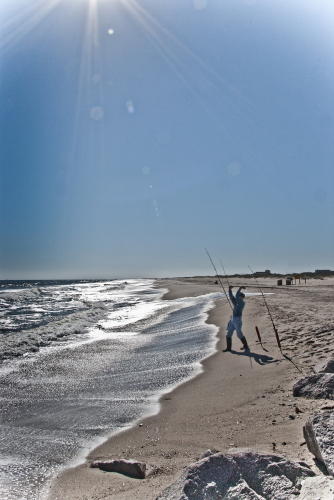 Keeping the fish alive…
Keeping the fish alive…
- Ice methods…
- Smaller live fish can be put into an ice chest that is filled with ice and they will go dormant almost instantly. Fully immerse them in the ice but don't lay them flat. Position them the way they would be while swimming. When you have several fish in one cooler, space them out. The rule of thumb is 4 pounds of ice for every 2 pounds of fish. And use crushed or flaked ice, not cubes. Drain off the water and refill with ice on a regular basis.
- You can kill the fish quickly and then remove the gills (or the whole head), gut the fish, and clean the abdominal cavity. Fill the abdomen with ice and put the fish into the cooler filled with ice. Remember to use crushed or flaked ice, and not cubes. Don't stack the fish on top of each other – space them out in the cooler. Drain off the water and refill with ice on a regular basis. By the way, the processing of gutting the fish and removing at least the gills, if not the whole head, and cleaning out the abdomen is referred to as "dressing" the fish.
How to get your fresh fish home safely - Ice It!
If you already have your freshly caught fish iced down in your cooler, then you're good to go! Remember to drain off any water in the cooler before starting home. If you don't have your fish already on ice, then you need to do that. Look at the icing methods above for instructions.
How To Keep Mollusks Fresh While You're Catching Them
Just like fresh fish, shellfish are very perishable; much more so that red meat or game. It's important to follow safe handling procedures while you're catching, digging or harvesting shellfish.
- Put an unopened bag of ice in the bottom of a cooler or ice chest – and then cover it with a lot of newspaper or a heavy towel. Put the shellfish on top of this and keep the lid closed. Don't let the shellfish sit directly on the ice.
- Another method of keeping shellfish fresh is to put a few frozen freezer packs in the bottom of a cooler and then cover them with several inches of seaweed. Splash the seaweed with saltwater. You can layer the shellfish and seaweed in the cooler.
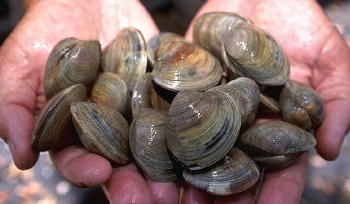 While clamming, oystering, or harvesting mussels…
While clamming, oystering, or harvesting mussels…
Once you get home, transfer the shellfish to a colander, or a container with holes, and cover them them wtih a clean moist towel. The shellfish need to be able to breathe, so you should never cover them with water. Put them in the refrigerator like this. Keep the towel moist until you're ready to cook them – this should be within 2 or 3 days at most. Remember to check and make sure that they are still alive. Do not store clams, mussels or oysters directly on top of ice. It's important to keep them cool, but you don't want them to freeze. Don't store them in plastic bags either – they will suffocate.
Before you cook or serve mollusks in the shell, they need to be alive.
- How to tell if a clam or mussel is still alive…
- If the shell is open, tap on it or squeeze it shut.
If it opens back up, then discard it and do not eat it.
- How to tell if an oyster is still alive…
- If the shell is open, tap on it with a hard object. The oyster should retract its foot and then close its shell very tightly. If it does nothing, then it is dead.
Dead oysters in the shell have a hollow sound compared to live ones.
- How to tell if a scallop is still alive…
- Live scallops will have their shell at least slightly opened. They should close at least slightly when pinched or tapped on the counter. Scallops really should be cleaned as soon as possible, as opposed to keeping them alive until just before you cook them. If you must keep them in the shell for a day, put them on a tray in your refrigerator and cover them with a damp cloth.
How To Keep Shrimp and Crabs Fresh While You're Catching Them
- While catching your own shrimp…
- Freshly caught shrimp need to be kept cold – put them in a cooler with crushed ice.
If you get lots of shrimp, alternate layers of ice and shrimp.
- While harvesting stone crab claws…
- Put the claws in a live well or an empty cooler until you get home. Don't put them on ice because the meat will stick to the shell. Keep the cooler out of the direct sun.
- Fill a cooler about 1/3 full of ice. Cover the ice with a baking sheet or a thin piece of wood. Don't let the crabs come into contact with the ice or the melting water. The temperature should be around 50 ° F - any lower can kill the crabs. Do not put ice on top of the crabs.
- Another method is to put the crabs into a wooden bushel basket and then cover that with a damp burlap sack. Keep them out of direct sunlight. The cooler method is better but not always practical.
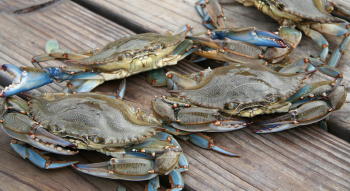 While catching blue crabs…
While catching blue crabs…
![]() Home
Home
![]() About
About
![]() Sitemap
Sitemap
![]() Credits
Credits
![]() Privacy
Privacy
![]() Advertise
Advertise
![]() Contact
Contact
![]()